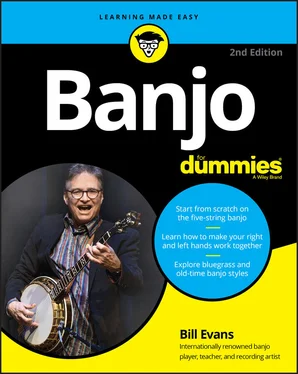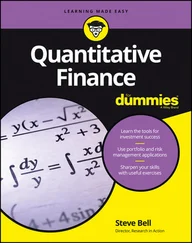However, I do assume that you're going to be playing a five-string banjo instead of a tenor or plectrum banjo, which are actually different kinds of instruments (see Chapter 1). I also assume that you want to get started quickly and not waste time with unnecessary and overly technical information. If I've described you in one way or another, you've come to the right place.
In the margins of this book, you can find the following friendly icons to help you recognize different types of information.
 This icon highlights the really good information that's not only worthy of your full attention but also likely to be something you'll come back to again and again.
This icon highlights the really good information that's not only worthy of your full attention but also likely to be something you'll come back to again and again.
 This icon points you to expert advice and time-saving strategies that can make you a better banjo player.
This icon points you to expert advice and time-saving strategies that can make you a better banjo player.
 You can consider information attached to this icon to be fun but not essential to playing the banjo. You may find it interesting (I do!), but you can skip over it if you're short on time.
You can consider information attached to this icon to be fun but not essential to playing the banjo. You may find it interesting (I do!), but you can skip over it if you're short on time.
 Exercise caution with text marked by this icon in order to protect yourself, your banjo, or your musical reputation!
Exercise caution with text marked by this icon in order to protect yourself, your banjo, or your musical reputation!
 This icon lets you know that there's an audio track and, in many cases, a video clip that demonstrates the concept, playing technique, or song discussed in the text. Check out these online resources at
This icon lets you know that there's an audio track and, in many cases, a video clip that demonstrates the concept, playing technique, or song discussed in the text. Check out these online resources at www.dummies.com/go/banjo to deepen your understanding and speed your progress.
In addition to the material in the print or e-book you're reading right now, this product also comes with some online goodies, available for easy access at your first jam session when you suddenly can't remember how to fret a G chord. Check out the eCheat Sheet at www.dummies.com/cheatsheet/banjo for helpful insights and pointers on reading chord diagrams, how to fret the chords you'll use the most, reading banjo tablature, and playing basic right-hand patterns.
You can also discover my list of ten jam session essentials, more practice hints, upgrades to banjo parts, and more at www.dummies.com/extras/banjo .
I've recorded numerous audio tracks and video clips so that you can view and listen to various techniques and songs discussed throughout the book. There's even a video to guide you through changing strings on your banjo. Go to www.dummies.com/go/banjo to download these files.
As a banjo player on a mission, you want to know where, when, and how you can get started. You can always read this book straight through, but the beauty of any For Dummies book is that you can direct your own course and dip into chapters as you need them.
As you create your own road map, I can offer you a few suggestions to point you in the right direction:
If you need to purchase a banjo or you're interested in an upgrade, head to the buyer's guide in Chapter 13first.
If you're a beginner with banjo in hand, and you want to start playing right away, proceed to Chapters 2and 3, where you get your banjo in tune and play your first chords.
If you're ready to start working on authentic banjo styles, roll up your sleeves and work through Chapters 5, 6, and 7.
If you're an experienced player, dig in by checking out intermediate to advanced old-time playing techniques in Chapter 8, more challenging bluegrass techniques in Chapter 9, and early American banjo styles in Chapter 11.
Part 1
The Amazing Five-String Banjo
IN THIS PART…
Discover the difference between various kinds of banjos and find the right kind of five-string banjo for the music you want to make.
Nothing sounds worse than an instrument out of tune, so find out everything you need to know about keeping your banjo in tune and sounding sweet.
Get comfortable sitting and standing with the banjo and find a comfortable left-hand position for fretting chords.
Read chord diagrams and banjo tablature — they're not as tough to decipher as you may think.
Play your first few chords, and then make music with easy to play right-hand strumming and picking patterns.
Chapter 1
You Want to Play What?: Banjo Basics
IN THIS CHAPTER
 Connecting to the world-wide banjo community
Connecting to the world-wide banjo community
 Getting to know different kinds of banjos
Getting to know different kinds of banjos
 Exploring the banjo and all its parts
Exploring the banjo and all its parts
 Starting on the road to becoming a great player
Starting on the road to becoming a great player
Before you begin any trip, you probably like to know where you're going. If you're new to the banjo and don't yet own an instrument or if you're wondering about your eventual musical destination, this chapter is definitely the place to start your Banjo For Dummies excursion. The key is in the ignition, so put this thing in drive!
In this chapter, you spread out your banjo road map and start planning what I hope will be a wonderful, lifelong musical journey with the five-string banjo. You see what makes the five-string banjo different from other kinds of stringed instruments, and you get to take a look at some of the various kinds of banjos available today. I name the parts of the banjo and preview the musical skills you'll master in this book on the way to becoming a great banjo player.
There's something about the five-string banjo that brings out strong feelings in people. Folks who like the banjo usually really like it, sometimes to the mystery, confusion, and even chagrin of those loved ones around them. What is it about this instrument that inspires such passion, and how can you tell if you've been bitten by the banjo bug? This section explores some answers to these questions.
Loving that amazing sound
You know the sound of the banjo when you hear it: the bright, rhythmic waterfall of short, cascading notes that can conjure up just about any emotion (but happy is usually the first to come to mind for the typical guy or gal on the street). The banjo is usually associated with folk, country, bluegrass, and old-time music, but these days, you can also hear the instrument in rock, jazz, and even classical settings.
Over the years, I've asked hundreds of amateur and professional players why they initially got interested in the banjo, and the usual answer is “I fell in love with the sound.” I think an equal attraction is the lure of hearing a lot of notes compressed into what seems like the smallest of musical spaces. In the hands of a skilled player, the banjo is an instrument that's capable of amazing virtuosity.
Читать дальше

 This icon highlights the really good information that's not only worthy of your full attention but also likely to be something you'll come back to again and again.
This icon highlights the really good information that's not only worthy of your full attention but also likely to be something you'll come back to again and again. This icon points you to expert advice and time-saving strategies that can make you a better banjo player.
This icon points you to expert advice and time-saving strategies that can make you a better banjo player. You can consider information attached to this icon to be fun but not essential to playing the banjo. You may find it interesting (I do!), but you can skip over it if you're short on time.
You can consider information attached to this icon to be fun but not essential to playing the banjo. You may find it interesting (I do!), but you can skip over it if you're short on time. Exercise caution with text marked by this icon in order to protect yourself, your banjo, or your musical reputation!
Exercise caution with text marked by this icon in order to protect yourself, your banjo, or your musical reputation! This icon lets you know that there's an audio track and, in many cases, a video clip that demonstrates the concept, playing technique, or song discussed in the text. Check out these online resources at
This icon lets you know that there's an audio track and, in many cases, a video clip that demonstrates the concept, playing technique, or song discussed in the text. Check out these online resources at  Connecting to the world-wide banjo community
Connecting to the world-wide banjo community










